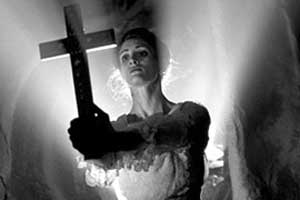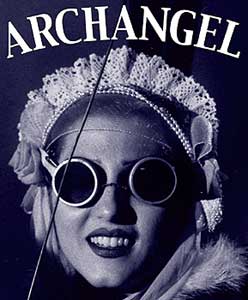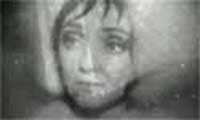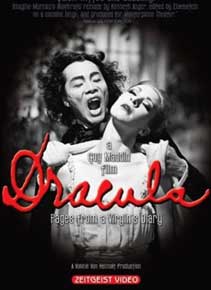Yet Another Three Films by Guy Maddin
Dracula: Pages from a Virgin's Diary (2001) is a spelndid homage both to the beautiful excesses of silent film acting styles, & the dark vintage beauty of Universal horror films -- in the form of a grand guinol ballet which I can imagine being attended & reviewed by a young Theophile Gautier & his roommate Charles Baudelaire.
There are many spoofy moments like the xenophobic nightmare of Lucy (Tara Birtwhistle) with foreigners instead of vampires, or the "color" returning to Lucy's cheeks in a largely black & white film, the arrival of Van Helsing (Dave Moroni) putting the kabosh on bitten Lucy's partying manner, & of course bug-eatin' Renfield (Brent Neale).
 Lucy's vampire-desiring death-dance is absolutely gorgeous, & the casting of Zhang Wei-quiang as Count Dracula is a lovely touch, given Lucy's xenophobia. Lucy's vampire-desiring death-dance is absolutely gorgeous, & the casting of Zhang Wei-quiang as Count Dracula is a lovely touch, given Lucy's xenophobia.
The dance of the little winged imps with Lucy's aged sickly mother (Stephanie Ballard) was especially marvelous. And the dance of Lucy's resurrection with Dracula, & her beheading by Van Helsing -- simply splendid with little dashes of red standing out against the b/w.
The second half is the story of Mina & Jonathan (Cindy Marie Small & Johnny A. Wright). Jonathan arrives at a Cocteau-esque take on Dracula's castle, wherein demonesses feed on an infant & Jonathan incites their deepest hunger.
Periodically there are inside-jokes for Dracula fans, starting with the bit on xenophobia which is from Stoker's novel but never before expressed so overtly on the screen. And Dracula's death includes a visual pun on Vlad the Impaler's history.
This film is unbelievably cool. It's got to be one of the hardest things to do, to film a ballet interestingly. Having done it as a silent film was just the trick to make it truly cinamatic (even if vintage cinematic).
The Royal Winepeg Ballet had been doing this performance a long while before Madden filmed it, & then he had full leeway to create imaginative sets never before seen, so that it looks like much more than dancers on a stage. The dancer's responded instinctually to this new environment & the need for tighter close-in choreography for the camera, facilitating the construction of a uniquely cinemiatic experience.
Since Maddin's films run the gamut of annoying to sheer genius, it can be dangerous to begin viewing them at random, as a viewer is apt to give up too soon. Dracula: Page's from a Virgin's Diary just might be a good place to start, for I really don't believe it'd take an art film maven who already knows about silent film Expressionism, or a ballet afficianado who couldn't make it to Winepeg, in order to enjoy this film. It'll delight most who adore artful cinema with an extra delight for all fans of vampire films & literature.
 Right from the opening title card for Archangel (2002) it has the look of a very early partially-sound film still under the sway of the silent era. Right from the opening title card for Archangel (2002) it has the look of a very early partially-sound film still under the sway of the silent era.
Set in 1919 in "northernmost Russia," no one in the village of Archangel knows that the Great War has ended, & the war rages on.
As a deadpan comedy, many of the film's routines fail, like the narrated lesson on Love spoofing morality & pride, & the satiric anti-German propoganda, moments which can be grating & void of successful humor.
The writing word for word is so blisteringly bad that the film really only comes to life when there are no title cards.
Fortunately there are long silent moments when imagery dominates, & these stretches are wonderful, with the overall feeling of a Russian silent film re-edited by Marcel Duchamp for his fellow surrealists.
Lt. Boles with one leg shot off & his memory erased by mustard gas meets a woman named Veronkha who looks exactly like his lost love Iris. She may or may not be married to the insane Captain Filbin, but Filbin certainly believes they're married.
A costume propoganda event is wondrously staged, visually like a dream within the larger dream of the overall film. But Philbin's dialogue impersonating John Wayne & the whole event being narrated comes close to destroying its effectiveness, the fault of the writing again, begging for more silence. Nevertheless, the "illumination play's" climax with Boles' & Veronkha's union is pretty darn cool.
It's worth yet another repeat of Maddin's own discription of this film, one of his personal favorites from his canon: "It's a Goya painting etched upon a child's windowpane in frost," alluding to Goya's most dispiriting visions of war-torn landscapes & child-devouring god. By making Archangel a comedy, however, it lacks Goya's passion & terror, & is much more Battleship Potemkin Lite.
 A visually lovely partial-sound homage to the silent film era, or a four-minute music video from a hundred-year-old film vault, A Trip to the Orphanage (2004) has too little content to amount to anything, though it is saturated with mood.
A visually lovely partial-sound homage to the silent film era, or a four-minute music video from a hundred-year-old film vault, A Trip to the Orphanage (2004) has too little content to amount to anything, though it is saturated with mood.
The scratchy score of piano & song really sounds like a recording from the 'twenties or 'thirties. Moments of the song are in sync with the face of Sarah Constible, who has the look of a D. W. Griffith silent film star emoting woe.
Her song is like a Hebrew prayer that narrate's a man's march through curtains of memory to the place of a misery-laiden child, concluding with his farewell to his mother.
It struck me as something Maddin knocked off one bored afternoon when something went wrong with the sets for The Saddest Music in the World which was being filmed about the same time. A Trip to the Orphanage like the dada films of Hans Richter, it doesn't have to mean anything, but it might mean something even so.
copyright © by Paghat the Ratgirl
|

